Top Ten from Vienna
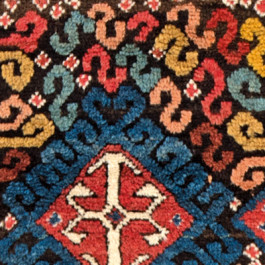
Austria Auction Company Top 10
10 images
With over 380 lots on offer at Austria Auction Company's next sale on 19 November, HALI's editor picks his choice of the lots with reference to value, rarity and artistic merit.
- Karaja, Persia, second half 19th century,13ft. 11in. x 7ft 1in. Lot 53, Azadi Collection, Austrian Auction Company, 19th November, estimate: € 25.000 – 35.000. This carpet is a distant relative of the Heriz, Karaja and Serapi carpets of the late 19th century, all of which captured the best aspects of Persian classical carpet design but within a strong local vernacular style. It is interesting to note that the designs seen at the extreme ends of the field are much more hooked and Caucasian in character. Conservatively dated to the second half of the 19th century, full pile carpets of this age do not unusually appear at auction.
- Tekke main carpet Turkmenistan, ca. 1800, 7ft. 4 in. x 6ft. 2 in. Lot 11, Azadi Collection, Austrian Auction Company, 19 November, estimate: € 20.000 – 30.000. The ivory ground ‘curled-leaf’ border defines this exceptional carpet as a rare beast. A few other carpets with this border have belonged to two English collectors: the Robert Pinner carpet now in a German private collection, and Neville Kingston’s carpet recently published in Turkmen Carpets (Tsareva, 2015, no.23). The rare secondary diamond gul, and tall main Tekke göls help to convey the multiple layers of the design grid implied by the numerous vertical and horizontal lines that run throughout the composition.
- Shekarlu rug, Qashqa’i tribe, southwest Persia, ca. 1860, 7ft. 0 in. x 5ft. 2 in. Lot 24, Azadi Collection, Austrian Auction Company, 19 November, estimate: €7.000 – 9.000. Siawosch Azadi is well known for his work on Turkmen weaving as well as Persian tribal rugs, and this carpet represents perhaps the best Fars area carpet in his collection. The field and border of this rug are not typical, the pride of lions patrolling between the hooked octagons in the border is particularly rare. Two examples published by James Opie in Tribal Rugs (1992, fig. 10.6-10.7) have lions in the field, but these are on white grounds and lack the density of decoration, profusion of unusual motifs and clarity of colour of the present example. The relatively low estimate should mean a good result in the auction.
- Lori kilim band, Persia, ca. 1900,10ft. 4in. x 0ft. 3in. Lot 380, Austrian Auction Company, 19th November, estimate: € 400 – 600. Tucked at the back of the sale are three woven bands made by west Persian nomads for use in packing and carrying loads. In a new study of these tribal totems by Fred Mushkat to be published in 2017, the authenticity and strong tribal identity that resonated through these objects is in revealed in great detail. For many years these weavings have been overlooked but the best examples deserve greater attention. This example may not be the finest of the three examples on offer but it does have the rare addition of animals and people.
- Hezar Djerib, north central Persia, ca. 1920,14ft. 0in. x 6ft. Lot 207, Austrian Auction Company, 19th November, estimate: €4.500 – 6.000. The publication of Undiscovered Minimalism by Werner Weber in 2011 revealed the pure minimal aesthetic of the covers woven in the Mazandaran region of Iran, well known for tea and silk production. This large cover would have been used to cover a variety of spaces including more expensive pile rugs. The rhythms of colour are like manna from heaven to many ruggies, and this example ranges through a colour spectrum rarely used in pile rugs. In our minds this is a lot of colour and cover for the money.
- Salor kapunuk, Turkmenistan, mid 19th century, 4ft. 2in. x 4ft. 6in. Lot 195, Austrian Auction Company, 19th November, estimate: € 35.000 – 45.000. If Salors were once considered rare, then Salor kapunuks were almost unknown. There are approximately eight known, including one in the V&A, London and another in the Russain Ethnographic museum. Most the examples have similar designs and colours, and may range in date from mid-19th century to 18th century. There was one on the market in the last few years, which still had its fine tassels attached, however this example has a beautiful range of colours, including the use of two colours of silk, and movement in the drawing which suggests that it is earlier in the 19th century than later. In comparison to previous auction results and prices on the private market, this does not appear expensive.
- Moghan sumakh, Azerbaijan, second half 19th century, 3ft. 2in. x 1ft. 9in. Lot 187 Austrian Auction Company, 19th November, estimate: €1.400 – 1.800. Although offered in a previous sale, this unusual sumakh bag is made up of two bags face fragment sewn together. The colours and wool quality of the bags from the Moghan area of the Transcaucasian region are always exceptional and reflect those of the rugs and flatweaves. There are only a few sumakh bags with the all-over Memling göl design, the best of which is in a US private collection. Although damaged the exceptional quality of this fragment is worthy of addition to any good collection.
- Kurdish long rug, west Persia, late 19th century, 13ft. 11in. x 5ft. 7in. Lot 179, Austrian Auction Company, 19th November, estimate: € 4.000 – 6.000. This interesting rug seems to have a design little known in pile rugs and echoes those seen on mafrash panels and sumakh bags. Although it is attributed to Kurdish tribes around Karaja in northern Iran, a n area with Azeri, Shahsavan and Talish populations. The addition of two prayer arches either end of the field mark this out as being a more interesting weaving deserving of collector interest.
- Zakatala rug, Caucasus, mid 19th century, 7ft. 7in. x 4ft. 6in. Lot 168, Austrian Auction Company, 19th November, estimate: € 20.000 – 30.000 This group of rugs was first identified in a 1994 article in HALI 78 by Tony Hazeldine, who classified a group of hitherto unknown rugs in the mosque of the eponymous capital of the region. They are typically associated with rugs with long fleecy pile but minimal designs and with limited palettes. This rug must be best of type from this little known weaving region, and combines elements associated with design such as Pinwheel designs and the ram’s horns seen on Perpedils. The slight corrosion of the brown ground gives the sharp outlines of the hooks a dynamic quality and allows the colours to stand out in away that is not seen in other rugs.
- Complete Saryk (Salor?) tent band, Turkmenistan, mid 19th century, 45ft. 11in. x 1ft. 2in. Lot 69, Azadi Collection, Austrian Auction Company, 19th November, estimate: €8.000 – 12.000. The silk highlights and fine weave helps to date this band as an earlier example. While many bands have been cut up, the rarity of complete examples has now propelled these wedding dowry items to new heights with collectors. The tentative attribution to either Saryk or Salor show relate this band to the weaving groups considered to tribes associated with earlier weaving tradition.



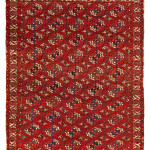
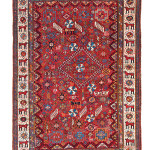
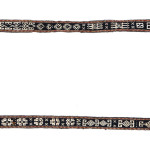

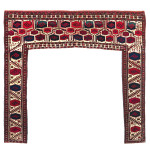
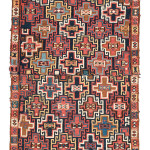
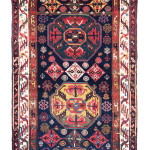
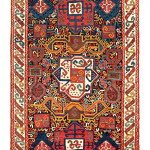
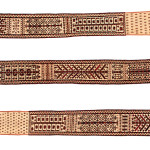























Comments [0] Sign in to comment